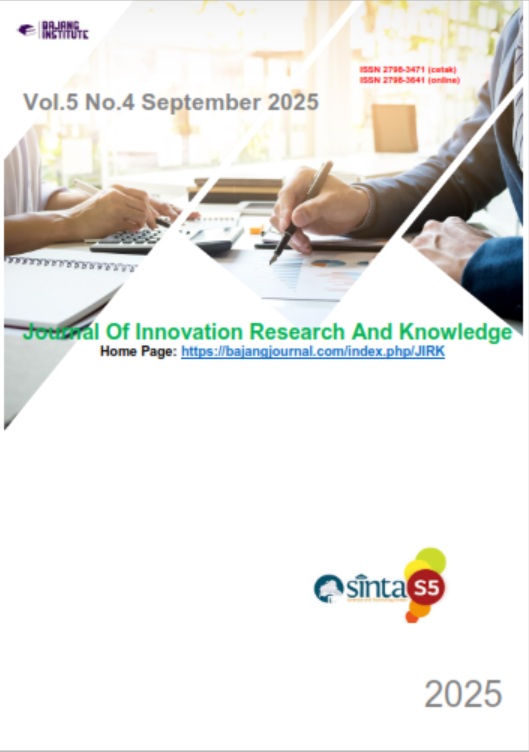PERBEDAAN PENGARUH SENAM AEROBIK MODERATE INTENSITY DAN HIGH INTENSITY TERHADAP KADAR GLUKOSA DARAH PADA PENDERITA DIABETES MELITUS TIPE II
DOI:
https://doi.org/10.53625/jirk.v5i4.11261Keywords:
Moderate-Intensity Aerobic Exercise, High-Intensity Aerobic Exercise, Blood Glucose LevelsAbstract
Type II diabetes mellitus occurs due to chronic metabolic disorders characterized by elevated glucose levels resulting from insulin resistance. Several factors contribute to increased glucose levels, including age, sex, body mass index (BMI), genetics, and occupation. If blood glucose remains uncontrolled and continues to rise, it can damage other organs and lead to complications. Moderate-intensity aerobic exercise consists of deliberately selected movements performed to music, targeting the aerobic system and carried out at a moderate intensity. In contrast, high-intensity aerobic exercise is a training program that combines moderate- and high-intensity movements to target both the aerobic and anaerobic systems. Both types of exercise aim to reduce blood glucose levels. Objective: This study aims to compare the effects of moderate- and high-intensity aerobic exercise on blood glucose levels in patients with type II diabetes mellitus. Method: This study employed quasi-experimental design with two-group pretest-posttest design. The sampling technique was purposive sampling, involving 16 participants who underwent an exercise program three times a week for four weeks. Group I performed moderate-intensity aerobic exercise, while Group II performed high-intensity aerobic exercise. A glucometer was used as the measurement tool. Results: Hypothesis tests I and II (p < 0.05) showed that both moderate- and high-intensity aerobic exercise had a significant effect on lowering blood glucose levels. Hypothesis test III (p < 0.05) indicated a significant difference between the effects of the two exercise intensities. Conclusion: There is a significant difference in the effects of moderate- and high-intensity aerobic exercise. High-intensity aerobic exercise has a greater effect on lowering blood glucose levels in patients with type II diabetes mellitus. Suggestion: Future researchers are encouraged to expand on this study by incorporating additional variables to provide more valuable scientific insights
References
Abdi, S., Tadibi, V., & Sheikholeslami-Vatani, D. (2021). Effect of high-intensity interval training on endothelial function in type 2 diabetic females. Asian Journal of Sports Medicine, 12(4), 2–7. https://doi.org/10.5812/asjsm.113566
Ahmad, A. M., Mahmoud, A. M., Serry, Z. H., Mohamed, M. M., & Abd Elghaffar, H. A. (2023). Effects of low-versus high-volume high-intensity interval training on glycemic control and quality of life in obese women with type 2 diabetes. A randomized controlled trial. Journal of Exercise Science and Fitness, 21(4), 395–404. https://doi.org/10.1016/j.jesf.2023.08.003
Anita Dyah Listyarini, Ilham Setyo Budi, & Zakiatun Assifah. (2022). Gambaran Kadar Glukosa Darah Sewaktu Pada Diabetes Mellitus Di Desa Sambung Kecamatan Undaan Kabupaten Kudus. Jurnal Kesehatan Dan Kedokteran, 1(2), 26–30. https://doi.org/10.56127/jukeke.v1i2.138
Darma, D. D., Sudirman, S., & Widiyanto, B. (2023). Low Impact Aerobic On Blood Glucose Levels And Peripheral Circulation In Type II Diabetes Mellitus Clients In 2022. Amalee: Indonesian Journal of Community Research and Engagement, 4(2), 543–553. https://doi.org/10.37680/amalee.v4i2.3014
Ervanti, Y., Puspitasari, Y., & Melda, B. (2023). Pengaruh Resistance Exercise Terhadap Nilai Ankle Brachial Index Dan Penurunan Kadar Glukosa Darah Pada Pasien Diabetes Melitus Tipe 2 Di Wilayah Kerja Puskesmas Poncokusumo Malang. Jurnal Keperawatan Muhammadiyah, 8(4), 107–115.
Firdaus, M. (2022). Pengaruh Senam Aerobik High Impact dan Low Impact terhadap Kadar Lemak pada Karang Taruna Putra. Jurnal Pendidikan Kesehatan Rekreasi, 8(2), 407–413.
Hermawan, A., Nahdliyyah, A. I., Rakasiwi, A. M., & Susanti, N. (2024). Aerobic Exercise Kombinasi Resisted Exercise Terhadap GDS Penderita Diabetes Mellitus Tipe II di Kota Pekalongan. 7(Juni), 72–79.
Kinasih, A., Mangalik, G., & Oktafiani, E. (2020). Pengaruh Senam Low Impact Terhadap Kadar Gula Darah. Jurnal Ilmiah Ilmu Keolahragaan, 4(1), 15–20.
Kolang, K., & Tapanuli, K. (2022). 1 , 2 1,2. 2(3), 953–960.
Lubis, R. F., & Kanzanabilla, R. (2021). Latihan Senam Dapat Menurunkan Kadar Glukosa Darah pada Penderita Diabetes Melitus Tipe II. Jurnal Biostatistik, Kependudukan, Dan Informatika Kesehatan, 1(3), 177. https://doi.org/10.51181/bikfokes.v1i3.4649
Poon, E. T.-C., Li, H.-Y., Kong, A. P. S., & Little, J. P. (2025). Efficacy of high-intensity interval training in individuals with type 2 diabetes mellitus: An umbrella review of systematic reviews and meta-analyses. Diabetes, Obesity & Metabolism, January, 1719–1734. https://doi.org/10.1111/dom.16220
Putro, W. A. S., Perdana, R. P., Hidayatullah, M. F., Doewes, M., Purnama, S. K., Supriyoko, A., Purnomo, E., Suwanto, W., Dewangga, M. W., & Widiyaningsih, W. R. (2023). The effects of high-intensity interval training on blood sugar levels in type 2 diabetes mellitus patients: A study in southwest Papua. Journal of Medicinal and Pharmaceutical Chemistry Research, 5(12), 1149–1158. https://doi.org/10.48309/jmpcr.2023.181875













